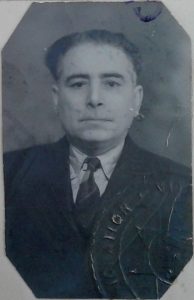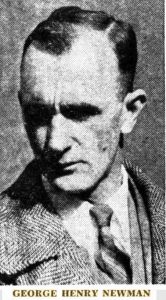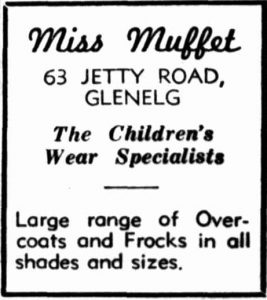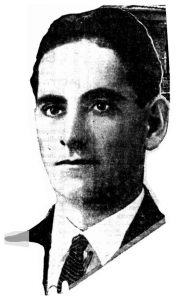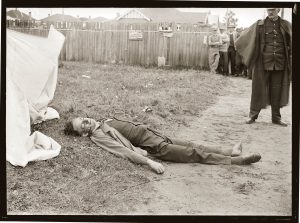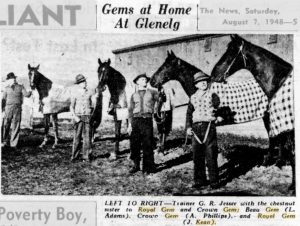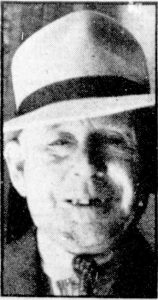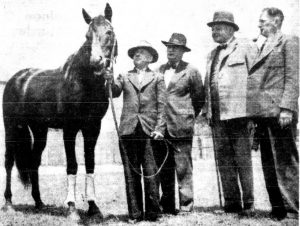Towards the end of last year, I went through a period where I tried to finesse different ways of raking through the Australian archives to pursue the Melbourne nitkeeper research thread in the Somerton Man cold case. (Which arose because two Melbourne baccarat players came forward in early 1949 to say that they thought the man had worked as a nitkeeper at a Lonsdale Street baccarat school for about ten weeks around 1945 or so.)
Despite meticulously stepping through story after story in Trove to reconstruct what I could of the Melbourne baccarat school timeline, all I could come up with was the Romanian name “Balutz” that appeared in a single article. And when I received a nice reply from the Public Records Office Victoria helpfully suggesting I look up the (admittedly not entirely dissimilar) Greek surname Balutis, I then followed that lead as far as I could, all the way to Triantafillos Balutis and Stelios Balutis.
The pair (presumably brothers or cousins?) had arrived in Melbourne on 16 Feb 1923, both travelling in 3rd class on the RMS Ormonde: but I could find no details of what ultimately became of Triantafillos Balutis. He had lived for eight years in America (always a good box to tick for Somerton Man candidates, and the juicier the Juicy Fruit the better); had lived largely invisibly since 1930; had worked within a horse’s sneeze of the main Lonsdale Street baccarat school (which, let’s not forget, was run by the Greek Christos Paizes); and yet by around 1948 had completely disappeared from sight. No wife, no family, no funeral, no nothing.
In short, Triantafillos Balutis seemed pretty much a perfect candidate for having been the Somerton Man, if (and I know it’s very much an ‘if’) the Somerton Man had been the Melbourne nitkeeper the two gamblers claimed he was. But I was short of the last pieces of evidence that would confirm or deny it. What I needed was a cunning Aussie insider, a well-disposed researcher who would go to the Melbourne archives and ferret out the last pieces of the puzzle.
And that is indeed what happened next…
A Surreal Day Out At Shiel Street
The modern building at 99 Shiel Street, North Melbourne is shared by both the National Archives of Australia and the Victorian State Archives. According to my generous (but doggedly anonymous) Melbourne mole (I’ve lightly edited their notes):
The modern bureaucracy makes visiting here quite surreal. I’ll explain why in case you have reason to go to Shiel Street in future.
The first thing to note is that there is a single reading room, and along one side of it there runs a single long L-shaped desk.
On the shorter side of the ‘L’ is a very nice librarian who hands over the National Archives Files. As far as possible from her, at the very top of the long side of that ‘L’ is the very nice librarian who hands over files from the Victorian State Archives.
Now, if it happens that you speak first to the NAA librarian, he or she will tell you that there is no public digital scanning facility: in fact, only the librarians are allowed to do that, and they will charge you per scan. Otherwise you can make ordinary photocopies at about three times you’d pay elsewhere… or you can bring a camera, or use your camera-phone.
However, if you happen to speak, instead, to the very nice Victorian Archives librarian at the other end of that long desk, you will be told that there’s no charge for anything. Not only that, but they have a dedicated side room (complete with professional-looking camera) where you are free to make hi-res digital scans if you prefer. All for no charge whatsoever. “All you need to bring is a USB stick” they will tell you over the phone.
And, oddly, neither of the nice librarians is wrong.
It seems that the commonwealth (=Federal) government won’t agree to let its records be snapped using Victorian government equipment, so if you turn up with just a USB stick for NAA docs, you’ll be out of luck.
Luckily I had both a usb and a phone… which is why I’m sending through a neat pdf of the (Victorian Archive) probate material and a whole lot of poorly-lit camera snaps of the really interesting NAA material.
Needless to say, I’m extremely grateful for the kindness this anonymous researcher hero showed.
Stelios Balutis
We can now say a little more about what happened to Stelios Balutis. In his July 1963 will, the (obviously misspelled) “Stelois Balutes” of 581 King Street West Melbourne did:
“[…] Give devise and bequeath all my Estate both real and personal unto my Trustees Upon Trust […] for my granddaughter ELEONORA ASSIKIS of Sinikismos Evangelistries Ano Skalakia Thessaloniki Greece if she attains the age of Twentyone years and if living at my death but she shall predecease me then Upon Trust for my grandson NIKOLAS ASSIKIS of the same address if he attains the age of Twentyone years and if living at my death.”
His estate amounted to $1381.15: and the notice of probate appeared in the 02 Sep 1977 edition of the Melbourne Age. The only thing I rather liked was the colour of the probate’s duty stamps (in the NAA scan):
The Victorian Archives had more about Stelios Balutis. I’ll spare you his fingerprints, but there was a perfectly nice photo of him from his 1948 passport (which I contrast-enhanced slightly for clarity):
All in all, nothing remarkable, then; but even so, more than enough to close our (admittedly small) chapter on Stelios Balutis.
Triantafillos Balutis
Because I had previously been able to access Triantafillos Balutis’ application for Australian naturalization via the NAA’s website (my attempts to do this were mainly hindered by the 20+ different spelling combinations of his first and last names), our Melbourne mole was able to find only a single page of additional information in the archives.
Luckily (or possibly unluckily, depending on your Somerton Man point of view), this was the most important page of all, because it revealed what ultimately became of him. This was from the Criminal Investigation Board, whose (small) file relating to Triantafillos Balutis’s naturalization was included separately in the NAA records.
At the end, the file noted: “Triantafillos BALUTIS appears on Passport List No. 2857 of 15/9/1949 Proceeding to Greece. CIB.”
Ships leaving Melbourne for Europe on the 15th September 1949 were (according to Trove) the Devon for London and the Port Vindex for Liverpool, or (on the 16th) the Dundalk Bay for Adelaide and Naples.
By far the most interesting one of these was the Dundalk Bay, which had just arrived from Naples accompanied by the Nelly, the two ships carrying more than a thousand migrants each from all over Europe.
The Australian archives contain nominal rolls (all nicely digitized and cross-referenced) listing all the incoming migrants for the Dundalk Bay and Nelly (in fact, these lists appear several times over). But as far as I can see, there is no sign of nominal rolls for passengers travelling in the opposite direction: presumably because nobody in their right mind would want to be going back to Europe in September 1949.
As a result, I wasn’t able to dig up anything as useful as a nominal roll for any of the three ships listed as leaving on the 15th/16th September 1949, to fully confirm the (already extremely likely) story that Triantafillos Balutis left Melbourne for Europe then.
Perhaps someone with better m4d archival sk1llz than me will be able to dig this up. But to be fair, there’s probably little point: this research strand seems to have also reached the end of its life. We’re done here, basically.
So… Back To Lonsdale Street, Then?
I’ve been thinking about this whole thing for a couple of months now, in a kind of methodological post mortem. And I think the way it all rolled out revealed weaknesses in the way I was approaching archival research. In essence, I jumped at the chance to pursue what (superficially) seemed like a substantial lead, because it seemed likely that I would be able to follow a research lead on a single person of interest right to the end line (which is indeed what happened).
Sure, this was a plausible (if slightly opportunistic / optimistic) plan, but at the same time it didn’t really amount to anything like a systematic, goal-directed attack on the archives. And in fact this was what was missing.
So, in retrospect what I should have done was try to devise ways to open up the Australian archives in respect of the Lonsdale Street baccarat schools, and particularly the Victorian police records. We know (thanks to the PROV) that there was nothing Balutz-related in the Victorian Police Gazette for 1944/1945/1946: but Balutz should only ever have been a helpful secondary angle to prise open the archival lid.
Because Christos Paizes was the big fish in the story, I now think it was Paizes’ Melbourne history that needed bringing into the light in a far more systematic way, rather than guessing and hoping.
Christos Paizes and his Henchmen…
The NAA records say that Christos Paizes was born on 5th February 1897 in Ithaca, Kionion, Greece: and that he arrived in Australia on 4th January 1914. His naturalization was in 13th August 1937, at which time his address was (the familiar-sounding address) 269-271 Lonsdale-street, Melbourne.
According to the sensational (but probably not entirely historically reliable) book “Gangland Melbourne“, Paizes (also known as ‘Harry Carillo’) allegedly had Freddie ‘The Frog’ Harrison and Norman Bradshaw ‘working’ for him. All the same, Harrison was mentioned quite openly here as having worked for Solomon’s baccarat school, so I’m not yet convinced that Gangland Melbourne completely nailed that one:
Police witnesses alleged Harrison was the constant companion of thieves, that as doorkeeper of a baccarat school in Elizabeth-street, city, he had many times given warning of the approach of police, and, that he had kept a supply of bullets in his home. Harrison said he was employed by the proprietor, Mr. Solomon, as doorman of the Rendezvous Bridge Club, until May 20. From a weekly wage of £5 he paid £3 board to his aunt, with whom he and his wife and child had been living for twelve months. He had nothing to do with the conduct of the bridge club.
He was also mentioned quite openly in this news story on Trove:
Described by detectives as former doorkeeper for a baccarat school mentioned in connection with an Elizabeth Street shooting on May 22, Frederick William Harrison, 26, of Peel Street, Windsor, laborer, successfully appealed to Judge Mitchell in General Sessions today against a three months’ gaol sentence for vagrancy.
This was the baccarat school in Fink’s Building, according to this report.
Even though Harrison was not convicted of the Elizabeth Street shooting, George Henry Newman (45) was, and in October 1947 went to jail for two years. There’s a picture of Newman in an article in the Sydney Truth, which to my eyes isn’t terrifically different from the Somerton Man:
There’s no details of when Newman was let out of jail: and Trove has no obvious further trace of him. Just sayin’, just sayin’… 😉
We know that Christos Paizes subsequently surfaced in Sydney, running (no surprises) a baccarat school there. According to the Sydney Crime Museum, (quoting the 1980 book Drug Traffic by Alfred McCoy, which – with the inevitable shipping from Australia – is currently sitting just outside my comfortable price range, though the British Library does have a copy) when casinos in the 1970s became the next ‘hot’ place for gamblers to go to:
The established Goulburn Club at 51-7 Goulburn Street, owned by George Zizinos Walker and Christos Paizes of South Coogee, simply added roulette to baccarat, recruited a bevy of hostesses, and polished up its image.
Putting all this together: it seems to me that if the Somerton Man was in some way connected with the Lonsdale Street baccarat schools, a far better first research step would be to map out the different Melbourne schools and all the crims and thugs associated with them, and only then with that groundwork in place start to look at individuals.
Back to the Archives?
And so the actual research question finally arrives: what is the best way of using Australian archive resources to try to reconstruct the Lonsdale Street baccarat school crim network circa 1945? After all, historians now spend so much of their time mapping out social networks, why not map antisocial networks too? :-p
Hence I think it’s the NAA’s B745 series that perhaps offers us the possibility of some kind of way in. However, when our marvellous Melbourne mole specifically asked the NAA about getting access to B745, the response was:
With regards to series B745, ‘Index of offenders investigated by the Commonwealth Police’, this is a collection of index cards which the National Archives does not have in custody. Although the series is registered with us it does not appear to have ever been transferred from the Australian Federal Police. Theoretically it may still be held by them, but previous attempts to identify their whereabouts have not been successful.
And so, for a change, one research door shuts only for another to also shut. There must surely be a way of locating B745 but… it will probably take a while.

